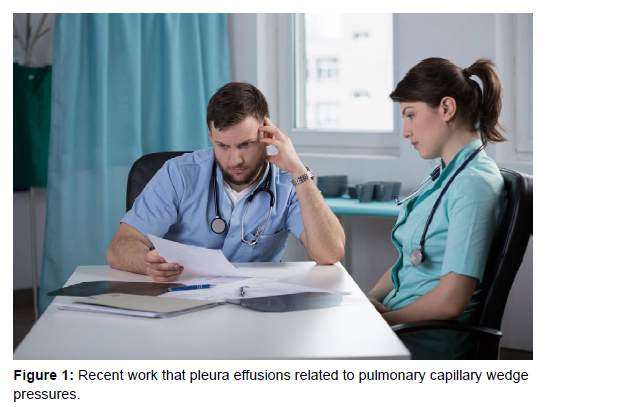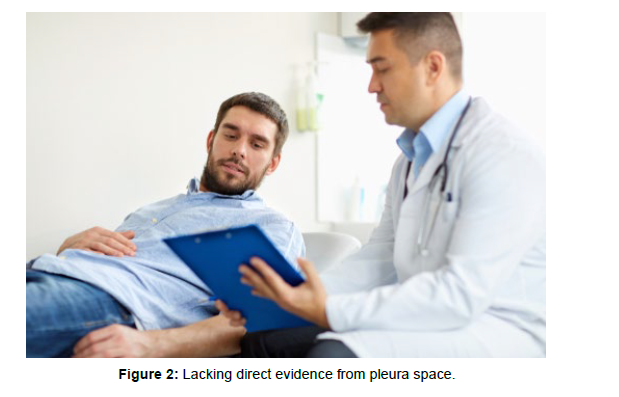Relationship of Pleura and Pulmonary Interstitial Liquid
Received: 28-Aug-2023 / Manuscript No. JRM-23-115753 / Editor assigned: 30-Aug-2023 / PreQC No. JRM-23-115753 / Reviewed: 14-Sep-2023 / QC No. JRM-23-115753 / Revised: 20-Sep-2023 / Manuscript No. JRM-23-115753 / Published Date: 27-Sep-2023 DOI: 10.4172/jrm.1000181 QI No. / JRM-23-115753
Abstract
The relevant pressures were identified as the pleura liquid pressure, the capillary and oncotic pressures in both the visceral and parietal membranes, and the oncotic pressure of the pleura fluid itself. The early models initially suggested a pressure-driven fluid flow from the parietal side across the pleura space to the visceral pleura and subsequently, into the pulmonary interstitial.
Keywords: Physiological amount; Lymphatic stomata; Experienced clinicians; Human pleura; Fluid formation; Pneumothoraxes
Keywords
Physiological amount; Lymphatic stomata; Experienced clinicians; Human pleura; Fluid formation; Pneumothoraxes
Introduction
Such models were derived from studies of animals with a thin visceral membrane, in which the blood supply originates from branches of the pulmonary arteries. Later, it was found that in some other mammals, including man, the visceral pleura is considerably thicker and the blood supply is from the systemic circulation. This means that once the fluid enters the pleura space, there is no clear local pressure gradient to explain its further distribution [1]. Thus, pressure models in man fall short in explaining the existence of a constant physiological amount of fluid in the pleura cavity and also, they do not give a clue as to the further fate of the fluid. In other words, volume control mechanisms need to be involved in addition to pressures. Today, we know that under normal conditions in humans, the physiological pleura fluid is formed in apical parts of the parietal pleura and is drained by lymphatic stomata which seem to be exclusively found on the parietal side and are most numerous in mediastina and diaphragmatic areas [2]. Thus, normal fluid exchange is dominated by the parietal side. Furthermore, there is probably a constant fluid flow from apical regions to mediastina and diaphragmatic areas within the pleura cavity. It seems likely that there is very little if any relevant fluid exchange on the visceral side under normal conditions. Methodology Furthermore, the parietal stomata possess valve-like structures to guarantee a unidirectional flow of fluid out of the pleura space. They may also have a role in maintaining a constant amount of fluid in the pleura space, which means they probably play a crucial role in volume control. However, the expert demonstrates how difficult it still is to understand the complex interrelationships of pleura pressures, fluid flows and anatomical structures [3]. Furthermore, it gives us an idea of the work that is needed to clarify the physiological and pathophysiological mechanisms in detail. Looking at the recent physiological and pathophysiological work, one of the messages is that pulmonary hypertension or right heart failure alone do not lead to the accumulation of pleura fluid, in spite of persisting statements in may clinical and radiological textbooks that effusions associated with congestive heart failure reflect right heart failure. Experienced clinicians have long questioned this, since it is very unusual for patients with pure pulmonary to develop pleura effusions [4 ]. Furthermore, recent work has shown that cardiogenic pleura effusions are closely related to elevated pulmonary capillary wedge pressures rather than to pulmonary artery or right heart pressures as shown in (Figure 1). Thus, cardiogenic pleura effusions are usually related to left ventricular dysfunction with pathological flow of interstitial pulmonary fluid into the pleura space across the visceral side. In animal models of cardiogenic pulmonary oedema, it has been shown that up to the oedema fluid exits the lungs via the visceral pleura into the pleura space [5 ]. Removal of this fluid by thoracentesis reduces systemic fluid overload and should contribute to a decrease in pulmonary capillary pressures. It is therefore rational to include a therapeutic thoracentesis in the treatment repertoire of congestive heart failure whenever there is a significant pleura effusion One of the other findings that may be of interest to the clinician is that the reserve capacity of the pleura space to clear extra fluid is probably quite substantial [6].
Discussion
Although we are still lacking direct evidence from the human pleura space, it seems probable from animal studies that the lymphatic drainage system can cope with up to several hundred millilitres of additional fluid per day without the development of an effusion [7]. Therefore, any pleura effusion represents a severe imbalance of pleura fluid formation or drainage capacity. In case of congestive heart failure, even a small pleura effusion signals a severe pulmonary fluid overload. On the other hand, the absence of effusions does not necessarily mean that the pleura drainage system is not already under severe stress as shown in (Figure 2). Surprisingly, we do not have a convincing answer to this [8]. Traditionally, it was thought that pleura syphilis should lead to a loss of lung function or at least to regional imbalances of ventilation. However, there is no evidence to suggest that lung function is significantly impaired in pleura syphilis and the numbers of imbalances of ventilation that have been described are negligible. In elephants the pleura space seems to be obliterated, perhaps by a kind of congenital pleurodesis [9 ]. Considering the size of an elephant's pleura cavity and the fact that the pleura liquid pressure becomes more negative with increasing body mass, it is likely that pleura effusions or pneumothoraxes would pose a severe threat to these animals. Thus, the evolutionary advantage of this phenomenon seems obvious, such species will not have to worry about pneumothoraxes. So, after all, it has been hypothesized that it could function as a drip pan for pulmonary oedema fluid [10]. We have shown that it can indeed play such a role, decades have passed since the introduction of pleurodesis and we are still unable to find reports of subsequent complicating pulmonary oedema, so we conclude that even this role is unlikely to be of clinical relevance [11]. Most thoracic surgical procedures would be very difficult to perform if the human pleura space had taken the evolutionary path of the elephant. It remains a philosophical question if this was really anticipated by Mother Nature or if the survival of the pleura space in man is rather a case of pure luck [12]. The early models initially suggested a pressure-driven fluid flow from the parietal side across the pleura space to the visceral pleura and subsequently, into the pulmonary interstitial. Such models were derived from studies of animals with a thin visceral membrane, in which the blood supply originates from branches of the pulmonary arteries [13 ]. Later, it was found that in some other mammals, including man, the visceral pleura is considerably thicker and the blood supply is from the systemic circulation. This means that once the fluid enters the pleura space, there is no clear local pressure gradient to explain its further distribution [14].
Conclusion
Thus, pressure models in man fall short in explaining the existence of a constant physiological amount of fluid in the pleura cavity and also, they do not give a clue as to the further fate of the fluid. In other words, volume control mechanisms need to be involved in addition to pressures.
Acknowledgement
None
Conflict of Interest
None
References
- Cohen SP, Mao J (2014) Neuropathic pain: mechanisms and their clinical implications. BMJ UK 348:1-6.
- Mello RD, Dickenson AH (2008) Spinal cord mechanisms of pain. BJA US 101:8-16.
- Bliddal H, Rosetzsky A, Schlichting P, Weidner MS, Andersen LA, et al (2000) A randomized, placebo-controlled, cross-over study of ginger extracts and ibuprofen in osteoarthritis. Osteoarthr Cartil EU 8:9-12.
- Maroon JC, Bost JW, Borden MK, Lorenz KM, Ross NA, et al. (2006) Natural anti-inflammatory agents for pain relief in athletes. Neurosurg Focus US 21:1-13.
- Birnesser H, Oberbaum M, Klein P, Weiser M (2004) The Homeopathic Preparation Traumeel® S Compared With NSAIDs For Symptomatic Treatment Of Epicondylitis. J Musculoskelet Res EU 8:119-128.
- Gergianaki I, Bortoluzzi A, Bertsias G (2018) Update on the epidemiology, risk factors, and disease outcomes of systemic lupus erythematosus. Best Pract Res Clin Rheumatol EU 32:188-205.]
- Cunningham AA, Daszak P, Wood JLN (2017) One Health, emerging infectious diseases and wildlife: two decades of progress? Phil Trans UK 372:1-8.
- Sue LJ (2004) Zoonotic poxvirus infections in humans. Curr Opin Infect Dis MN 17:81-90.
- Pisarski K (2019) The global burden of disease of zoonotic parasitic diseases: top 5 contenders for priority consideration. Trop Med Infect Dis EU 4:1-44.
- Kahn LH (2006) Confronting zoonoses, linking human and veterinary medicine. Emerg Infect Dis US 12:556-561.
- Bidaisee S, Macpherson CNL (2014) Zoonoses and one health: a review of the literature. J Parasitol 2014:1-8.
- Cooper GS, Parks CG (2004) Occupational and environmental exposures as risk factors for systemic lupus erythematosus. Curr Rheumatol Rep EU 6:367-374.
- Parks CG, Santos ASE, Barbhaiya M, Costenbader KH (2017) Understanding the role of environmental factors in the development of systemic lupus erythematosus. Best Pract Res Clin Rheumatol EU 31:306-320.
- Barbhaiya M, Costenbader KH (2016) Environmental exposures and the development of systemic lupus erythematosus. Curr Opin Rheumatol US 28:497-505.
Indexed at, Google Scholar, Crossref
Indexed at, Google Scholar, Crossref
Indexed at, Google Scholar, Crossref
Indexed at, Google Scholar, Crossref
Indexed at, Google Scholar, Crossref
Indexed at, Google Scholar, Crossref
IndexedAt , Google Scholar, Crossref
Indexed at, Google Scholar, Crossref
Indexed at, Google Scholar, Crossref
Indexed at, Google Scholar, Crossref
Indexed at, Google Scholar, Crossref
Indexed at, Google Scholar, Crossref
Indexed at, Google Scholar, Crossref
Citation: Saunders M (2023) Relationship of Pleura and Pulmonary InterstitialLiquid. J Respir Med 5: 181. DOI: 10.4172/jrm.1000181
Copyright: © 2023 Saunders M. This is an open-access article distributed underthe terms of the Creative Commons Attribution License, which permits unrestricteduse, distribution, and reproduction in any medium, provided the original author andsource are credited.
Share This Article
Recommended Journals
Open Access Journals
Article Tools
Article Usage
- Total views: 650
- [From(publication date): 0-2023 - Apr 27, 2025]
- Breakdown by view type
- HTML page views: 438
- PDF downloads: 212


